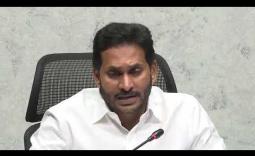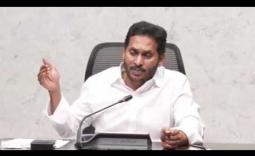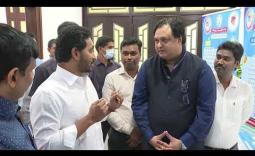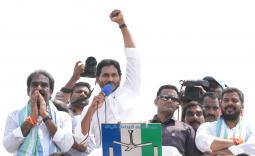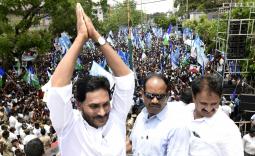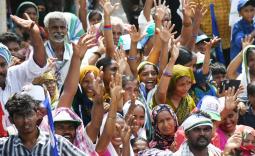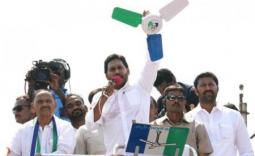Jagan blames Naidu for chaos in pension distribution Don’t fall prey to Naidu’s shallow promises: CM
Don’t fall prey to Naidu’s shallow promises: CM Vote for Naidu is inviting leeches in to homes: CM
Vote for Naidu is inviting leeches in to homes: CM Choose between progressive Jagan, regressive Babu, CM tells voters
Choose between progressive Jagan, regressive Babu, CM tells voters  Opposition in disarray; Vote for welfare
Opposition in disarray; Vote for welfare Babu..why was he desperate to form an alliance?
Babu..why was he desperate to form an alliance? Vote with wisdom, vote for welfare, says CM YS Jagan
Vote with wisdom, vote for welfare, says CM YS Jagan  The Land Titling Act is not a decision of the State Government
The Land Titling Act is not a decision of the State Government Naidu’s promises will evaporate into thin air: CM YS Jagan
Naidu’s promises will evaporate into thin air: CM YS Jagan If you vote for Jagan, all the schemes will continue...
If you vote for Jagan, all the schemes will continue...
YSRCP MLAs' 11-page letter to Speaker
04 Jan 2014 2:23 PM
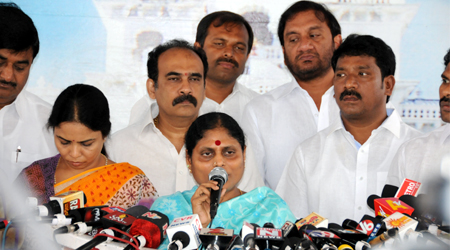
To
The Hon’ble Speaker
AP Legislative Assembly
HYDERABAD.
Respected Sir,
We the Members of the Andhra Pradesh
Legislative Assembly do hereby submit a Petition under Rule 167 of the Business
Rules of AP Legislative Assembly opposing the division of the State of Andhra
Pradesh for the following reasons:
The YSR Congress party vehemently opposes the
division of Andhra Pradesh, as it is being initiated not only against the
established Constitutional Conventions, procedures and Federal spirit, which
has since been declared as a basic feature of the Constitution of India but
also because it results in an absolutely unjust division of the state from the
point of view of the people of Andhra and Rayalaseema regions.
Apart from the undemocratic and
unconstitutional manner in which the State is sought to be bifurcated, on a
factual basis too, the division will force incalculable injustice on the
residual state as it will be deprived of (a) the engine of economic growth (b)
proportional revenues (c) assured river waters (d) employment opportunities and
(e) social, educational and health care infrastructure. It will take them
atleast fifty years to reach the same level of development which the
entrepreneurs from Andhra and Rayalaseema regions have created in HMDA area.
All this happening against the interests of a
vast majority of the people of the state and despite the Justice Srikrishna
Commission recommending keeping the state united in the larger interest of the
people of the state! If the division
does not go through, the Telangana region does not suffer either economically
or otherwise and on the other hand, if the division goes through the Coastal
Andhra and Rayalaseema regions will fall behind by fifty years for no mistake
of theirs. This is what Srikrishna Commission said:
“Subsequently, the state saw significant economic and social progress
for over three decades. As a result, Andhra Pradesh today stands as one of the
front runners among the progressive states in the country. Indeed, it could
arguably be said that this very progress has led Telangana to revive the demand
for a separate state in order to gain greater political space”
Why is the UPA Government going ahead with the
division despite opposition from a vast majority of people of Andhra Pradesh
and a overwhelming number of MLAs in AP Assembly?
Why is the Union Government, which has
virtually lost people’s mandate in the country, losing one state after the
other electorally, is bifurcating the state at the fag end of its ten year
rule?
Is it not done with the sole aim of securing a
few more seats for the ruling Congress party from the Telangana region by
igniting regional passions in that region for separate statehood?
The Union Government seems to have least
respect not only for the federal spirit of the Constitution but also for all
the established Constitutional conventions and the observations made by two
important Judicial Commissions on Centre-State relations viz Justice Sarkaria
Commission and Justice Punchhi Commission which effectively required the Union
Government to initiate the process under Art 3 of the Constitution only on the
basis of recommendation of a Commission/Committee appointed for that purpose or
upon receipt of a request from the concerned state assembly.
It is intriguing as to why the Union
Government, which has consistently followed these practices/conventions in
respect of creation of all the earlier states, has chosen to make a departure
only in respect of division of Andhra Pradesh, particularly when the sole
Judicial Commission viz Justice Srikrishna Commission that went into the issue
of creation of Telangana state, in its elaborate 461 page report strongly
recommended that the best among available options was to keep Andhra Pradesh
united. The excerpts from that Report are quoted below:
‘At the end of the investigation, it began to appear that there was a
case both for a separate Telangana as well as for keeping the state united.
Some other options, particularly bringing into focus the issue of backwardness
of Rayalaseema region and some other parts of the state, were also suggested by
different stakeholders and these too have been examined. After considering all
aspects, the Committee found the balance tilting in favour of keeping the state
united…..
The united Andhra option is being suggested for continuing the
development momentum of the three regions and keeping in mind the national
perspective. With firm political and administrative management it should be
possible to convey conviction to the people that this option would be in the
best interest of all and would provide satisfaction to the maximum number of
people in the state. It would also take care of the uncertainty over the future
of Hyderabad as a bustling educational, industrial and IT hub/destination. For
management of water and irrigation resources on an equitable basis, a technical
body i.e. Water Management Board and an Irrigation Project Development
Corporation in expanded role have been recommended. The above course of action
should meet all the issues raised by Telangana people satisfactorily.”
It is unfortunate that the Union Government,
even without discussing this important report compiled by the Srikrishna
Commission, which has compiled the voluminous Report after holding discussions
with all-important stakeholders across all the regions of the state over a
period of ten months, has, all of a sudden, arbitrarily and without at least
obtaining the resolution from the AP Assembly, initiated the process for
forming Telangana state. It is absolutely inexplicable as to why the Union
Government had appointed this Judicial Commission and as to why they are
ignoring their report and recommendations made there in. Is it not because the
findings of the report have gone against the Union Government’s pre-meditated
decision?
It is perplexing as to how the Union
Government thought it fit to take up only the Telangana issue ignoring all
other similar demands, some of which have been pending for longer periods than
that of Telangana. For instance, the States Reorganization Commission has
recommended the creation of Vidarbha state with Nagpur as capital way back in
1956. The UP Assembly passed resolution recommending four-way division of Uttar
Pradesh some three years ago. Why is the Government ignoring the demands from
Gorkha land and Bodo land and many other regions for separate states?
The Union Government was clearly aware of the
need to follow a consistent procedure for creation of new states. The following
statement made by the Union Home Ministry in Parliament on 1st August 2000 on
the subject of separate statehood for Vidarbha makes this amply clear.
“In 1953-54, a States
Reorganisation Commission was constituted and Indian States were reorganized on
linguistic basis. It will be in fitness of things if another States
Reorganisation Commission is constituted today. There have been different
demands from different states as well as different regions. The people of
Vidarbha raised a particular demand, which is opposed by the people of rest of
Maharashtra. We have taken the line that we can accede to a demand from a
particular region only if due weightage is given to it by passing a resolution
to that effect in the State Legislative Assembly. It does not mean that we will
concede everything passed by the State Assembly but with regard to creation of
a State, the Assembly resolution signifies a general consensus.”
It is important to note that even Sri P
Chidambaram, the then Union Home Minister in his Statement dealing with the
subject of Telangana on 9th December 2009 said that an appropriate resolution
will be moved in the state assembly. His statement is reproduced below:
“The process of forming the state of Telangana will be initiated. An
appropriate resolution will be moved in the state assembly.”
In the light of all the aforesaid established
Constitutional conventions, the action of the Union Government is absolutely
untenable. As a responsible political party committed to Constitutional
democracy and rule of law, we have requested the Hon’ble Prime Minister and HE
the President of India on several occasions in the recent past to stall this
undemocratic action of creating Telangana state without obtaining the
resolution from the state assembly. We have also requested the Hon’ble
Governor, Hon’ble Chief Minister and Hon’ble Speaker of State Assembly through
our several letters to immediately convene state Assembly and obtain the
resolution of the Legislative Assembly on the subject of division of the state.
Unfortunately, the process of division is going ahead without complying with
any of the Conventions/practices. Surprisingly, the draft of the Andhra Pradesh
Re-organization Bill 2013 was introduced in the State Assembly without
obtaining the consent of the Assembly on the division of the state.
The draft of the Andhra Pradesh
Re-organization Bill 2013, apparently prepared with great haste, was sent to
state Legislature for offering their views without even mentioning the Objects
and reasons for the Bill and without providing any background information on
any of the important issues This clearly shows that the Union Government does
not want any informed discussion and debate on various issues that directly
impact the lives of over 8.4 cr people of the state. This practice would set a
new dangerous precedent in the future in diving any state without having to
obtain the consent of the people by way of a Resolution in the state Assembly.
There are
certain unique problems as far as AP are concerned.
Unlike other state capitals, Hyderabad
Metropolitan Region has emerged during the last 57 years not only as a
political capital of Andhra Pradesh but also as a super economic and employment
power house with all the Public Sector and Private sector manufacturing units
along with civil and defence research laboratories being located in HMDA. Large
numbers of industrial investments that have come up in and around Hyderabad in
the last 57 years were only because it happened to be the capital of Andhra
Pradesh as a whole; otherwise, some of these investments would have been spread
out among other regions of the State.
For instance, the Central Government used the
public sector as the main vehicle for the economic growth of the country till
mid-1990s. Unfortunately, in case of Andhra Pradesh, 90% of these investments
had come up in and around Hyderabad City, unlike in other States, where they
were evenly spread out among all the regions. For example, the BHEL that was
sanctioned to AP was located in Greater Hyderabad as against UP locating it in
a remote place like Hardwar and Tamilnadu locating in Trichy. When it comes to
HAL, AP located it again in Hyderabad while Orissa located it in a tribal area
called Koraput and Maharashtra located in Nasik. Same is the case with HMT, BDL,
IDPL, ECIL, BEL, Midhani, NFC, NMDC, NRSA, NGRI, NFDB, DMRL, HCL, DLRL, DRDL,
CCMB, IICT and DRDO. With the result, the entire ancillarization also took
place in and around Hyderabad. Now, some of these units in private sector have
grown into global giants.
More than 90% of the private sector investment
that came to Hyderabad was from entrepreneurs from Andhra region, who were for
decades before independence known for their entrepreneurship and business
acumen. Some of these private enterprises have grown global. For example, out
of Rs. 55,000 crores of Software turnover (domestic plus exports) from Andhra
Pradesh for the year 2012-13, Hyderabad city itself accounted for Rs, 54,800
crores. As a result, Andhra and Rayalaseema regions have essentially remained
as agrarian districts.
All the institutions of higher learning like
IIT, ISB, IIIT, IIFT, NALSAR, CENTRAL UNIVERSITY, BITS, TISS, TIFR and health
care are also located in this area. Telugu film industry, which produces
India’s largest number of movies in a year, is fully located in Hyderabad. Such
an abnormal concentration of all the economic activity has not happened in any
state in India with the possible exception of Bangaluru.
As a result, about 60% of the States own
revenues are collected in HMDA area and about 75% state’s own revenues accrue
in Telangana, which has a population share of just 40%. This was not the case,
for instance, in the case of new States that were formed, viz., Jharkhand,
Uttarakhand and Chhattisgarh. Receipts from Sales Tax (VAT) approximately
account for 65% of state’s own revenues. Following is the excerpt from
Srikrishna Commission Report on sales tax:
“2.6.02 Sales Tax Accruals by Regions
In the year 2008-9, a total of just over `22 thousand crores was the
sales tax accrual in Andhra Pradesh. Incidentally, almost 75% of this amount
was collected from Hyderabad alone. The sales tax collection is undertaken as
per the sales tax division and often one division can cover more than one
district. However, broadly it can be said that excluding Hyderabad city, the
business activity is concentrated in coastal Andhra where just about 15 % of
all sales tax collection takes place. Tax collection in Telangana is about 8%
and Rayalaseema is just about 3%.”
So, if the division goes through, the residual
state will end up getting just 25-30% of the revenues of Andhra Pradesh, if the
revenues of 2012-13 are apportioned on the basis of district wise accruals,
while it comprises 60% of the geographical area and population of AP. There is
no power under Constitution for dividing one state’s revenue with others. Only
Union revenues can be shared with states under Article 280 of the Constitution.
The biggest problem will therefore be with revenues. How can the residual
Andhra state pay salaries and pensions of Government employees, let alone
investing in infrastructure and other development and social activities? How
can the residual Andhra state repay the loans which are sought to be
apportioned on the basis of population? Revenues of the residual state will be
25-30% of the present Andhra Pradesh state while the liabilities of the
residual state will be on the basis of population, which is 60% of AP’s
population. Will this be not a death
knell for the people of the residual state?
With the Central Government disinvesting and
not investing anymore in the public sector since 1991, how can they promote
another BHEL, HMT, ECIL, NFC, BEL, BDL, DMRL, DRDL, DRDO, HCL, MIDHANI, HAL,
NRSA etc in divided Andhra state? With the removal of licensing law, how can
Central Government direct the flow of private investments to any state?
How can Central Government ensure the 60%
share of software business and in turn employment opportunities to the residual
state, particularly when the Central Government, adding insult to injury,
recently decided to set up ITIR in HMDA area, where there already exists huge
software activity?
Without all these high profile economic
activities and given the complete bankruptcy of the Central Government how do
we get money to run the new state? Will Andhra remain only an agrarian state
and that too without assured water forever and for what mistake they committed?
Is it because they developed Hyderabad city into a super economic powerhouse
believing that it is their capital. Well, all those enterprises and
entrepreneurs may continue to remain in Hyderabad only; what about Andhra and
Rayalaseema regions?
Regarding sharing of river waters, it is
important to note that presently, there is no proper mechanism in place to
oversee water releases to various states in proportion of their allocations
under various river basins particularly in years of rainfall deficit. In the
absence of such a body regulating the releases right from the origin, the upper
riparian states have been utilizing many times more water than what they are
legitimately entitled ignoring the directions from Supreme Court, Inter-state
Water Tribunals and Central Government to release water to lower riparian
states, as the water releases are made by upper riparian states only after
filling their dams. In the years of flooding, water anyway flows into tail end
states inundating large parts and creating havoc. In the years of rainfall
deficit, the upper riparian states are not releasing waters to tail end states
in proportion of their entitlements. The principle is that pain and pleasure
have to be shared equally.
Currently, while the Tribunals and Boards
exist in the United AP, we have a situation wherein Maharashtra releases the
water to Karnataka after their requirements are met and it is seen that
Karnataka releases only after their dams (Almatti and Narainpur) are filled.
While this is the situation when the state is united, things are bound to
become worse when another state comes up in between and in that eventuality how
will Srisailam and Nagarjunasagar dams get the water? Right from Kuppam, the
Southern part of the state to Srikakulam, the state has no fresh water other
the sea water. So, how can the Government divide the Krishna ayacut which
comprises two and half districts in Telangana and eight and half districts in
Rayalaseema and Coastal Andhra? Would it not lead to everyday fights?
So, how without a quasi-judicial or judicial
body with powers of prosecution etc in place to manage the whole river basin,
it is possible to ensure that water is released to tail-end states in
proportion of their entitlement in right time, particularly in years of
rain-fall deficit?
Similarly, how can Polavaram Irrigation
project, which has been declared as a National project be implemented without
assured water and without looking into issues of submergence?
What the Telangana protagonists are now
demanding is a Telangana state that never existed as an exclusive political
entity at any time in the history. In fact, the creation of Andhra Pradesh was
done as part of the nationwide policy of creation of linguistic states on the
basis of Recommendations of States Reorganization Committee. It is to be
understood that Andhra Pradesh was not the only State that was created on
linguistic basis in 1956. Three other linguistic states have come up in South
India itself in 1956, while several others have come up on that basis all over
the country. Similarly, it is not just Telangana region that was merged with
another province to create a new linguistic state as part of States
Reorganization in 1956; several other provinces too were either merged or
demerged to create new linguistic states as part of countrywide States
Reorganization on linguistic basis. For instance, from the erstwhile princely
state of Hyderabad, the Telangana region comprising 10 districts were merged
with Andhra state to form Andhra Pradesh, while the Marathi speaking 6
districts of Maratwada were merged with Maharashtra and 3 Kannada speaking
distyricts of Hyderabad state were merged with Karnataka state. It is relevant
to recall what Srikrishna Commission at para 1.1.10 of their report stated:
‘The Hyderabad Assembly discussed an official resolution on SRC Report
from November 25 to December 3, 1955. The trend of the debate was that, out of
the 174 members of the House barring the Speaker, who participated in the
discussion, 147 members expressed their views. Of these, 103 favoured
Vishalandhra, 29 favoured independent Hyderabad state and 15 remained neutral.
From the residuary states, 59 wanted Vishalandhra, 25 separate Hyderabad state
and 1 was neutral.’
When such an overwhelming majority of
legislators belonging to erstwhile Hyderabad state favoured merging of
Telangana with Andhra for formation of Vishalandhra, how can one say that it
was forced upon them? Is it not a fact that a resolution was also passed in
Andhra state assembly for formation of Andhra Pradesh? Is it also not a fact
that Sri Burugula Ramakrishna Rao, the then democratically elected Chief
Minister of Hyderabad state had stepped down to pave way for formation of
Andhra Pradesh?
Moreover, why is the Central Government
creating this major problem, when their financial position is the worst since
independence? They cannot even give a few thousand crores for creation of a new
capital, let alone compensating the new State for the loss of their revenues
besides the social, economic and educational infrastructure. How will the new
State survive? Is it not a fact that the Union Government has not honoured its commitment
as regards the extending financial support to Uttarakhand, Jharkhand and
Chhattisgarh for building their capital cities?
The only consideration that the Union Cabinet
has shown to Andhra region is to allow it to have its state capital in Hyderabad
for a ten years period! Who will give the money to replicate Hyderabad city in
Andhra region, that too in just ten years? It is like forcibly vacating the
owner of a house, which he had so laboriously built for a period of 60 years,
and give him permission to stay in the house for rent for ten years i.e. till
he completes construction of new house, which is any way impossible!!
So, looked from any angle, the division of
Andhra Pradesh after 57 years of its creation, particularly when people of
Andhra, Rayalaseema regions and even by some in Telangana region are tooth and
nail opposed to such division, is therefore fraught with serious consequences
not only within AP but also for the whole country. AP is among the fastest
developing states in the country having third highest GDP in current terms,
next only to UP and Maharashtra. All the three regions have registered good
growth. The Telugu language is the second largest spoken language in the
country and has recently been declared as Ancient Language by the Union
Government. What then is the rationale for division of the state at this stage?
After all, in a liberal democracy like ours, we need a rational and objective
basis for taking any decision. If regional passions in a region will be
considered as the basis for dividing a state without taking into account
similar passions in other region, we are afraid, we will end up creating more
states than what we united in 1947, which is a serious enough threat for the
unity and integrity of the country.
To sum up --We oppose the move for the division of the State of Andhra
Pradesh
(a)because
majority of people in the State and their elected representatives are
vehemently opposed to the division of Andhra Pradesh;
(b) as
it is being done apparently without any valid basis and in complete disregard
to the prevailing conventions and practices which require the Union Government
to initiate action under Article 3 of the Constitution of India for creation of
new states only upon receipt of the request from the state assembly by way of a
resolution;
(c) as the Union Government did not obtain the
Resolution of the State Assembly as was done in case of creation of
Uttarakhand, Jharkhand and Chhattisgarh states before initiating steps under
Art 3 of the Constitution of India;
(d) because the same goes against the
recommendations of the Justice Srikrishna Committee constituted by the Union
Home Ministry in February 2010 for Consultations on the Situation in Andhra
Pradesh, which suggested that the best among available options was to keep the
State united;
(e) because the same goes against the spirit
of Federalism which is one of the basic features of Indian Constitution;
(f) as the same goes against the observations
made by Justice Sarkaria Commission (1988) and Justice Punchhi Commission
(2010) on Centre-State relations in respect of creation of new states under Art
3 of the Constitution of India;
(g) because the same goes against the policy
statement by the Union Home Ministry on the floor of Lok Sabha on 1st August
2000 which categorically stated that new states could be created only either by
constituting the Second States Reorganization or upon receipt of request from
the concerned state assemblies;
(h) because the same goes against the
recommendations of the Seventy-Fourth Conference of the Presiding Officers of
Legislative bodies in the country held at Bhopal during February 3-4, 2010 with
Smt. Meira Kumar, Speaker of Lok Sabha in the Chair which resolved that, in
future, creation of new states or smaller states should be done only on the
basis of the recommendation of States Re-organization Commission;
(i) because it is being done without an
objective evaluation that Article 371-D has failed;
(j) because the division will force
incalculable injustice/loss on the residual state as it will be deprived of (a)
the engine of economic growth (b) job opportunities to educated youth (c)
proportional revenues (d) assured river waters and (e) social, educational and
health care infrastructure.
It is relevant to note that neither the AP
Congress Manifesto of 2004 or 2009 nor the UPA Government gave any categorical
assurance of creation of Telangana state. They are reproduced below:
AP CONGRESS MANIFESTO 2004:
THE TELANGANA ISSUE
“The Congress Party recognizes the growing aspiration
of the people of Telangana Region for Statehood. There are similar demands from other parts of
the country. The Congress Working
Committee, at its meeting held on 30th October, 2000 considered this issue in
proper perspective and resolved that "while respecting the report of the
first States Reorganization Commission, the Congress Party notes that there are
many valid reasons for formation of separate States in Vidarbha and
Telangana. However, the Reorganization
of existing States raises a large number of issues. The Congress Party feels that the whole
matter could be best addressed by another States Reorganization Commission to
look into all the issues involved".
AP CONGRESS MANIFESTO 2009:
“On the Telangana issue, the Congress Party pledges to
honour the stand taken by the Government on the floor of the House. The
Congress Government has already constituted a Committee of Members of both the
Houses under the Chairmanship of senior Congress leader Sri K. Rosaiah. The
report is awaited.”
PRESIDENT ADDRESS 2004 ON TELANGANA:
The Sarkaria Commission has last looked at the issue
of Centre-State Relations over two decades ago. The Government will set up a
new commission for this purpose, keeping in view the sea-changes that have
taken place in the polity and economy of India since then. The National
Development Council (NDC) will be made a more effective instrument of
cooperative federalism. The Inter-State Council will also be activated.
The Government will consider the demand for the
formation of a Telangana state at an appropriate time after due consultations.
It is clear from the above that no
unconditional assurance was ever given that Telangana state will be formed. So,
looked from any angle, the division of Andhra Pradesh after 57 years of its
creation, particularly when not only people of Andhra, Rayalaseema regions but
also many in the Telangana region are tooth and nail opposed to such division,
is therefore fraught with serious consequences not only within AP but also for
the whole country. AP is among the fastest developing states in the country
having third highest GDP in current terms, next only to UP and Maharashtra. All
the three regions have registered good growth.
What then is the rationale for division of the
state at this stage? After all, in a liberal democracy like ours, we need a
rational and objective basis for taking any decision. If regional passions in a
region will be considered as the basis for dividing a state without taking into
account similar passions in other regions, we are afraid, we will end up
creating more states than what we united in 1947, which is a serious enough
threat for the unity and integrity of the country.
We would like to submit that we have already
submitted Affidavits to the Hon’ble President of India conveying our opposition
for the division of Andhra Pradesh. In the light of the above, we oppose the
division of Andhra Pradesh.




